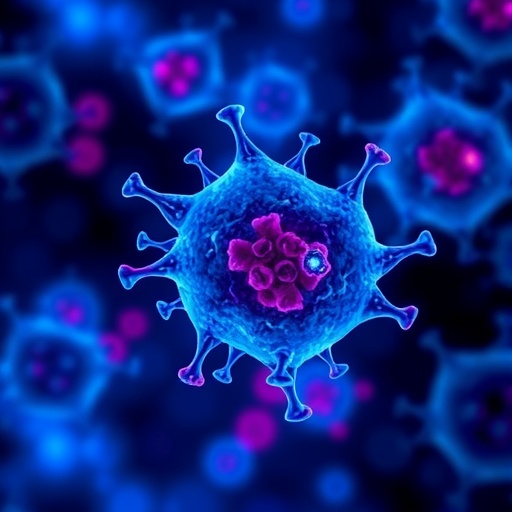In a groundbreaking advancement poised to reshape modern immunology and cancer therapeutics, researchers at Fox Chase Cancer Center have unveiled a previously unknown immune defense mechanism that fundamentally challenges long-held scientific assumptions. Their study, published in the prestigious journal Nature, centers on unraveling the intricate roles of a protein known as ZBP1 (Z-DNA binding protein 1), a sentinel molecule traditionally recognized for sensing viral genetic material within infected cells.
For decades, immunologists accepted that ZBP1 functioned exclusively by detecting invading viral nucleic acids, triggering infected cells to undergo programmed death and thus halting viral replication. However, this new investigation reveals that the stimulus activating ZBP1 is not solely derived from viral components. Instead, infected host cells themselves manufacture a molecular distress signal—an unexpected finding that rewrites the biological script on how antiviral defense pathways are initiated and regulated.
The molecular actor behind this signal is a specialized nucleic acid configuration termed Z-RNA. Unlike typical RNA molecules, Z-RNA adopts a distinct zigzagging left-handed helical structure which serves as a molecular beacon alerting the cell’s internal defense network. This self-generated Z-RNA emerges from endogenous retroelements embedded within the host genome, remnants of ancient viral infections once dismissed as genomic “junk.” These retroelements, now thrust into the spotlight, produce Z-RNA that activates ZBP1 and orchestrates a cascade leading to necroptosis, a form of programmed cell death vital for containing viral spread.
Importantly, this revelation that Z-RNA signals arise intrinsically from the host cell’s own genome, rather than exclusively from invading viruses, overturns foundational immunological dogma. Siddharth Balachandran, PhD, Director of the Center for Immunology at Fox Chase and senior author on the study, emphasized the paradigm shift this discovery represents. By demonstrating that host-generated Z-RNAs are the triggers for antiviral defense, the research opens unprecedented avenues for manipulating these pathways therapeutically.
The implications extend profoundly into the realm of cancer immunotherapy. Normally, tumors exploit immune tolerance mechanisms to evade detection and destruction by the body’s defenses. However, by chemically activating the same cellular machinery that produces Z-RNA during infections, scientists can artificially compel cancer cells to mimic viral infection. This “viral mimicry” strategy tricks the immune system into recognizing tumors as dangerous, potentially enhancing immune-mediated eradication of cancers that currently resist immunotherapeutic approaches.
This novel approach represents an innovative strategy to broaden the scope and efficacy of cancer immunotherapies. By reactivating endogenous retroelements within tumor cells, researchers effectively transform “cold” tumors into “hot” ones—immunologically active tumors capable of attracting and stimulating potent immune responses. The chemical agents under development aim to precisely stimulate this pathway, thereby releasing a molecular “red alert” that galvanizes immune cells to attack malignant tissues.
The trajectory leading to this landmark study is grounded in extensive prior work elucidating how influenza virus infection induces necroptosis through the activation of ZBP1. Building on these insights, the team uncovered that the death of infected cells is a deliberate, coordinated immune response rather than random cytopathic damage. Further investigations characterized ZBP1 as the molecular sensor detecting infection, linking its activity to severity of inflammation and disease progression.
Subsequent mechanistic studies highlighted that the generation of Z-RNA was the initiating molecular event activating ZBP1-dependent necroptosis. This recognition refined our understanding of the molecular interplay between virus and host cell, setting the foundation for current revelations. The latest research compellingly argues that it is the host cell’s own genomic elements, rather than the virus per se, that prompt the protective response, an insight with far-reaching implications.
Looking forward, Fox Chase scientists, in collaboration with the Molecular Modeling Facility, are spearheading the design of novel small molecules capable of safely and selectively triggering these antiviral pathways in cancer cells. This approach promises to surmount the limitations of existing immunotherapies by harnessing fundamental viral defense mechanisms intrinsic to human cells, thus energizing the immune system to recognize and eliminate malignant cells more effectively.
This line of inquiry marks a convergence of virology, immunology, and oncology, leveraging millions of years of evolutionary “genomic fossil record” to innovate therapeutic strategies that were previously unimagined. Reprogramming the immune system to perceive tumors as virally infected holds substantial promise for transforming cancer treatment paradigms.
In essence, by decoding how cells autonomously generate Z-RNAs as distress signals, the research offers a blueprint for harnessing a hidden dimension of innate immunity. This promising avenue offers hope for novel therapies that convert the body’s own cellular alarm systems into powerful weapons against both viral diseases and cancer.
As this exciting chapter in biomedical research unfolds, it may illuminate unexplored aspects of immune regulation and inspire next-generation therapeutics that blend molecular biology with clinical innovation. This transformative understanding widens the horizon for combatting diseases that have long eluded effective treatment.
Subject of Research: Cells
Article Title: Host cell Z-RNAs activate ZBP1 during virus infections
News Publication Date: 13-Oct-2025
Web References: Host cell Z-RNAs activate ZBP1 during virus infections | Nature
References: DOI: 10.1038/s41586-025-09705-5
Image Credits: Fox Chase Cancer Center
Keywords: Viral infections, Cancer
Tags: antiviral defense pathwayscancer research innovationscancer therapeutics breakthroughendogenous retroelementsFox Chase Cancer Center researchimmune defense mechanismimmunology advancementsmolecular distress signalsprogrammed cell deathviral genetic material detectionZ-RNA structureZBP1 protein role





